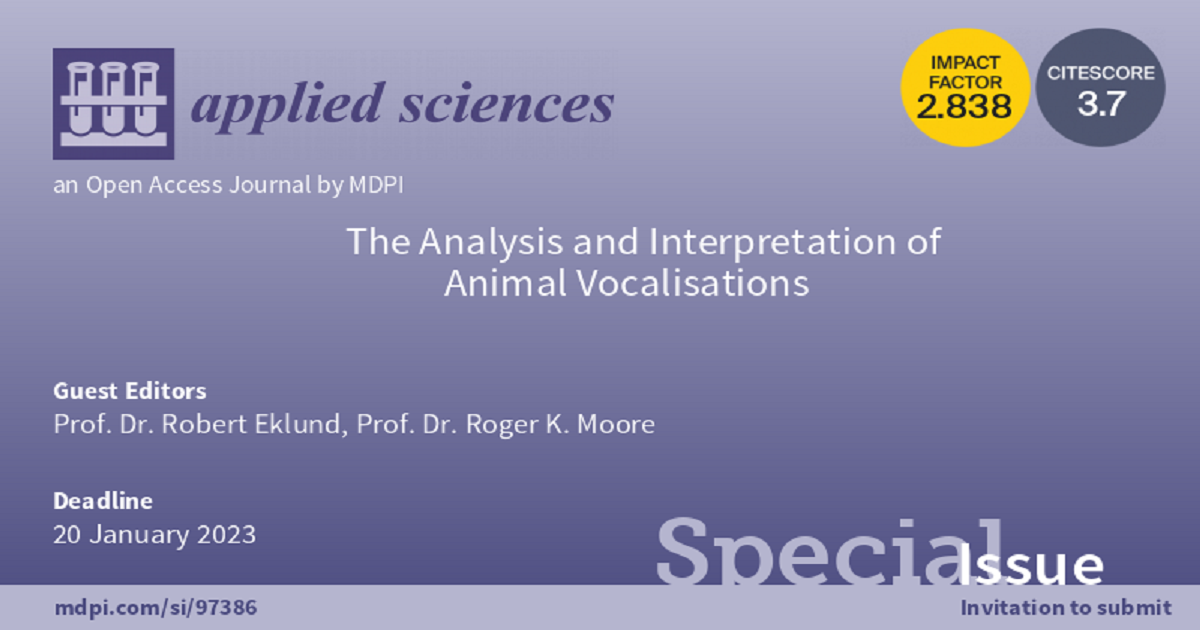- 2.5Impact Factor
- 5.5CiteScore
- 20 daysTime to First Decision
The Analysis and Interpretation of Animal Vocalisations
This special issue belongs to the section “Acoustics and Vibrations“.
Special Issue Information
Dear Colleagues,
It is often assumed that only human beings enjoy the benefit of a rich and expressive communication system in the form of spoken language. Animals also vocalise, and some have extensive repertoires, but what are they saying? Are animals simply advertising their presence, defending their territory or warning of predators, or are they engaging in conversations that are outside the comprehension of other species? What is clear is that animals signal their mental states, both to themselves and to others, and that because acoustic signals are manifest in a public space, they are available both within and across species. How are such signals managed and exploited, then? What conditions do particular sounds use, what are the acoustic characteristics of these sounds, and to what extent are paralinguistic states common across species? These are critical questions that are being addressed by the scientific community, and this Special Issue aims to bring together our latest understanding of the function and purpose of animal vocalisations and their relation (if any) with human spoken language.
Potential authors are encouraged to submit original research papers that describe emerging approaches in the study of animal vocalisations, review papers that capture the state of the art, and position papers that provide theoretical insights and identify outstanding research issues. Suitable topics include but are not limited to:
- The relationship between human language and the different signalling systems employed by non-human animals;
- Acoustic characteristics of animal vocalisations and the relationship between such characteristics and hearing and habitat/sound propagation;
- The degree to which there is a contrastic phonological structure to animal vocalisation;
- Measurement of the complexity of vocal interactions;
- The mental representations associated with vocalisations;
- Methodological issues with respect to cross-species annotation;
- Animal vocalisations as codes/ciphers;
- The rhythmic substrate to vocalisation and links to music;
- The role of feedback in the management and structure of vocalisation;
- Cross-individual and cross-species vocal learning.
Prof. Dr. Robert Eklund
Prof. Dr. Roger Moore
Guest Editors
Manuscript Submission Information
Manuscripts should be submitted online at www.mdpi.com by registering and logging in to this website. Once you are registered, click here to go to the submission form. Manuscripts can be submitted until the deadline. All submissions that pass pre-check are peer-reviewed. Accepted papers will be published continuously in the journal (as soon as accepted) and will be listed together on the special issue website. Research articles, review articles as well as short communications are invited. For planned papers, a title and short abstract (about 250 words) can be sent to the Editorial Office for assessment.
Submitted manuscripts should not have been published previously, nor be under consideration for publication elsewhere (except conference proceedings papers). All manuscripts are thoroughly refereed through a single-blind peer-review process. A guide for authors and other relevant information for submission of manuscripts is available on the Instructions for Authors page. Applied Sciences is an international peer-reviewed open access semimonthly journal published by MDPI.
Please visit the Instructions for Authors page before submitting a manuscript. The Article Processing Charge (APC) for publication in this open access journal is 2400 CHF (Swiss Francs). Submitted papers should be well formatted and use good English. Authors may use MDPI's English editing service prior to publication or during author revisions.

Benefits of Publishing in a Special Issue
- Ease of navigation: Grouping papers by topic helps scholars navigate broad scope journals more efficiently.
- Greater discoverability: Special Issues support the reach and impact of scientific research. Articles in Special Issues are more discoverable and cited more frequently.
- Expansion of research network: Special Issues facilitate connections among authors, fostering scientific collaborations.
- External promotion: Articles in Special Issues are often promoted through the journal's social media, increasing their visibility.
- e-Book format: Special Issues with more than 10 articles can be published as dedicated e-books, ensuring wide and rapid dissemination.

